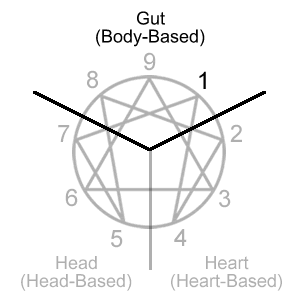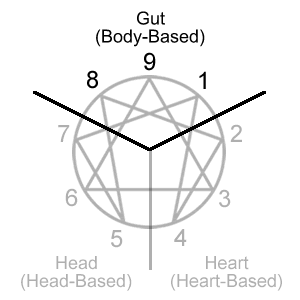Enneagram Type 1 Center: Gut/Body-Based Type

The Gut Center
Type 1 is located in the 891 triad which is often described as the gut or body-based center.
-
There are several ways to interpret what the gut or body types represent. They may be thought of in terms of sensory-somatic (bodily felt sensation), sensory-motor (physical movement and activity), or instinctual (gut decision making).
This may involve taking action based on one's gut instinct, getting pulled along by the agenda of others, and actively trying to correct what's seen as wrong in the world.
Type 1 is often very task-oriented. There can be a lot of activity around organizing, correcting, and improving what seems out of place or doesn't measure up to standards for how things should be. It's hard not to notice when things are not done properly and there is room for improvement. The impulse is to point out to others what needs to be done or correct things themself. This may also involve montoring one's own behavior and that of others.
Type 1 Anger
The anger triad consists of types 8, 9, and 1. Anger for these types involves the gut or body center. It can be thought of as an energy of will that pushes against obstacles to create movement or resists being pushed.
This may involve pushing through obstacles to get what one wants, stubbornly resisting attempts to be pushed in an undesired direction, and getting people to see what's right and correcting things not done right.
Although from the outside type 1 can sometimes appear angry, anger is not usually recognized by the type 1. Instead it takes on other forms such as irritation and criticality, often directed foremost at the self. It's generally felt internally as an energy in service of getting things right or getting others to see what's right. It can sometimes be expressed externally as self-righteous anger or judgment.
Type 1 Behavioral Center
The core focus of the Enneagram types labels the 891 triad as the Behavioral Center to more clearly differentiate how those types use that center.
- Type 8: Behavioral Assertiveness - pushes through obstacles to get what's wanted.
- Type 9: Behavioral Accommodation - yields to or joins in with the flow of movement.
- Type 1: Behavioral Correctness - discerns right from wrong and acts accordingly.
What Enneagram authors say about the gut center

Below are samplings from some popular or well-known Enneagram authors. Click on the sources after the descriptions to further explore these interpretations.
-
The Instinctive Triad1
Types Eight, Nine, and One are concerned with maintaining resistance to reality (creating boundaries for the self that are based on physical tensions). These types tend to have problems with aggression and repression. Underneath their ego defenses they carry a great deal of rage. -
Body-based Intuition: Points Eight-Nine-One2
- Eight - Sense of physically enlarging oneself “to fill the space.” Sensing the qualities of presence and power in people and in situations.
- Nine - Taking others within oneself. Like a mirror that absorbs the impression of whoever stands before it, reflecting a replica back to the beholder. At the time of connection the Nine feels merged with the other’s point of view.
- One - Sensing the possibility of perfection in ordinary events. What is incorrect stands out because it is sensed as a foreground error that mars the ongoing perception of “how perfect things could be.”
-
Body Center3
If you are a Body Center type (Eight, Nine, or One) you tend to filter the world through an intelligence of kinesthetic and physical sensations and gut instinct. You use personal position and power to make life be the way you sense it should be. You devise strategies that ensure your place in the world and minimize discomfort. When threatened, anger and rage occur. -
The Anger or Gut Triad (8, 9, 1)4
These numbers are driven by anger: Eight externalizes it, Nine forgets it, and One internalizes it. They take in and respond to life instinctually or “at the gut level.” They tend to express themselves honestly and directly. -
The Gut or Instinctive Center (Anger)5
- Eights present a strong image and are not afraid to express their anger.
- Nines are agreeable, accommodating, and can often be out of touch with their anger.
- Ones see anger as a character flaw and try to hold it back. They follow standards of behavior closely and/or try to better the world.
-
The “body” center (Points 8, 9, and 1)6
includes the “motor” center, which takes an active part in all physical movement, and the “instinctive center,” which corresponds to our instinctual functions. When thought initiates movements within you, your motor center is activated. An impulse from the motor, or gut, center can be a solid guide to right action, but misuse of the motor center can also lead to impulsive behavior or inertia.
Sources
1Book: The Wisdom of the Enneagram; Website: The Enneagram Institute
2Book: The Enneagram; Website: The Narrative Enneagram
3Book: The Essential Enneagram; Website: Dr. David Daniels
4Book: The Road Back to You
5Book: The Enneagram Made Easy
6Book: The Complete Enneagram; Website: Chestnut Paes Enneagram Academy
The Tri-Centers
The tri-center approach to the Enneagram types looks at an individual in terms of three types, one type from each of the three centers (i.e., gut, heart, and head). There may also be a preferred order to those three types (i.e., primary, secondary, and tertiary centers).
-
The Gut Type
If your primary or basic Enneagram type is 1 then your primary center is the gut center and type 1 is your gut type.
The remaining two types in your tri-center will come from the other two centers.
The Heart Type
Your heart type will be type 2, 3, or 4.
The heart types are focused on interpreting, expressing, and reacting to one’s own emotions or the emotions of others. More specifically, the heart center focuses on what's emotionally significant in the sense that emotions are an indication of how strongly a person resonates with or against something or someone.
This may involve being attentive to the emotional needs and desires of others, seeking emotional affirmation for oneself from others, and expressing one's own unique emotional impression of the world.
The Head Type
Your head type will be type 5, 6, or 7.
Although the head types can be thought of in terms of reasoning, analyzing, and other typical thinking functions, a useful distinction from the other two centers can be made in terms of anticipating and preparing for future possibilities.
This may involve gathering data and facts in order to better predict outcomes, preparing for negative potentialities that might occur, and planning or pursuing activities that provide enjoyment and avoid discomfort.
-
Possible Tri-Centers for Type 1
1-2-5 1-5-2
1-2-6 1-6-2
1-2-7 1-7-2
1-3-5 1-5-3
1-3-6 1-6-3
1-3-7 1-7-3
1-4-5 1-5-4
1-4-6 1-6-4
1-4-7 1-7-4
Enneagram Tests to Help Determine Centers

The Enneagram personality types group the nine types into three centers of intelligence often referred to as the gut, heart, and head centers.
These tests help you find your dominant type in each center and the order of preference for those centers.
-
Dominant Type in Each Center with Wings Test
This test determines your dominant type in each center (aka tri-center, trifix, tritype, truetype) along with the wings of those types.
Use when you want to know your tri-center or tri-center with wings. -
Enneagram Type Preference Test
This test produces a scored list of all nine types.
Questions are forced-choice, similar to the method used by the Riso-Hudson Enneagram Type Indictor (RHETI).
Use to determine type, wings, gut/heart/head types, and tri-center. -
Center Type Comparison Test
This test scores the three types in a given center to determine your dominant type within that center (gut, heart, or head type).
Use when you don't know your dominant type for one of the centers. -
Type Comparison Test
This test compares any two types, producing a score for each.
Use when unsure of your tri-center order or which of two types is preferred for a center.
To learn more about Enneagram personality type 1 click here.
Click here for the Complete Guide to the Enneagram.
This free guide explains- the nine Enneagram personality types
- the many type variations within type
- where the types came from (origins and history)
- how the types use the Enneagram symbol
Click here for Enneagram tests.
These free tests help you find your- primary type
- candidate types
- preferred wing
- intinctual subtype
- instinctual variant stacking
- center types (gut, heart, and head)
- tri-center with wings